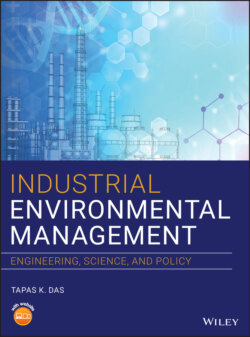Читать книгу Industrial Environmental Management - Tapas K. Das - Страница 51
1.12 Constraints and Challenges
ОглавлениеThe implementation of Zero Emissions faces constraints and challenges, as well as new opportunities. For example, the use of dissipative materials poses a design challenge: If solvents and flocculants are no longer to be used, what would it be replaced? Chemical manufacturers need to work with design engineers to arrive at an understanding of the constraints of separation technologies so that manufacturing any material without emissions is difficult, but working with chemicals is particularly challenging because of the need to develop nontoxic materials that are also biodegradable. Two possible solutions are biological.
Biopolymers are an outgrowth of chemurgy, the division of applied chemistry that deals with industrial utilization of organic raw materials, especially from agro‐business. These substances, complex molecules formed in biological systems, can replace toxic, dissipative materials currently used as adhesives, absorbents, lubricants, soil conditioners, cosmetics, drug delivery vehicles, and textile dissipative. Substitutes for toxic materials and mechanical processes to substitute for dissipative materials are aspects of the same principle.
Enzymes are natural catalysts that speed up chemical reactions without being consumed in the process. They function best in mild conditions, so their use requires up to one‐third less energy than many synthetic chemicals; paradoxically, this lower need for energy can be an obstacle in a system that still rewards large‐scale energy use with reduced rates. Enzymes are especially useful in systems designed to reduce or eliminate dissipative losses.
There is also a need for a taxonomy of environmental technologies that clarifies opportunities for fast developing, generic processes to address such recurring problem as process large streams of contaminated water from various processes and oxidation in air. Chemical engineering and related professions ought to be able to make rapid advances in such areas.
Many of the industries in the investment recovery or “decomposer niche” are hard put to compete against large‐scale facilities that produce materials from virgin materials. More recently, however, economies of scale for resource extractors and processors, along with cheap energy supplies, have been introduced almost everywhere in the world. For example, economies of scale have enabled chemical companies to produce plastics at a price that other manufacturers, as well as the individual consumer, can afford.
